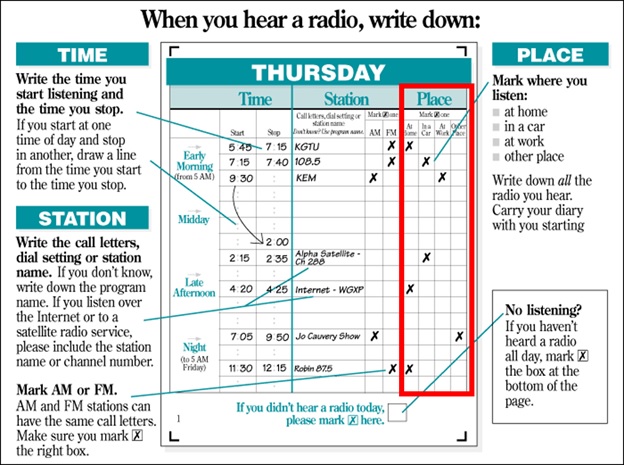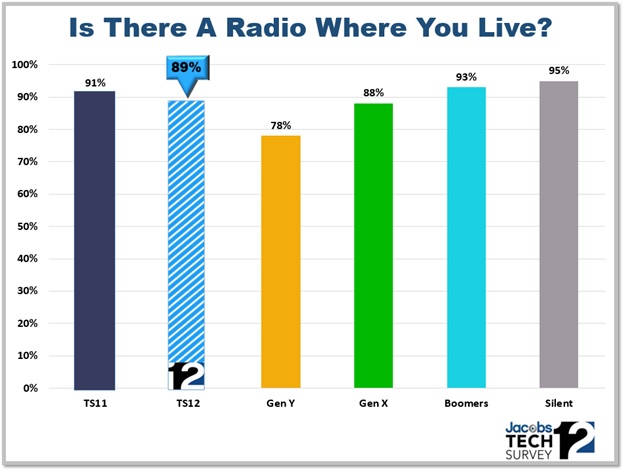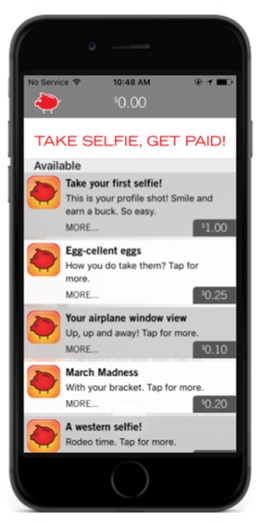
It’s an old axiom in real estate that it’s all about location, location, and yes, location. A great house is a great house, but in the wrong neighborhood, its value is suspect.
In radio parlance, location is the mantra as well because the medium’s success has always been predicated on ubiquitous access at home, at work, and in the car. For those of you in PPM markets, you may recall that one of the features of the old diary methodology was the boxes on the far right where respondents checked off their listening location.
This data provided programmers and marketers with valuable information about how and where consumers used radio, and as you might expect, the data varied from station to station. That’s because it’s not just about what you’re programming and when it airs, but also how it fits into the environment in which people find themselves throughout their days and nights.

Listening at work was always a big deal because of the possibility that a diarykeeper in a workplace, office, or on a construction site might draw a line down a block of hours, like 9-to-5, to denote listening to a station all day while on the job. If that happened across several days, the ratings gains could be impressive.
Today in PPM, we don’t get to see that same location granularity because the only two categories are listening that occurred in the home or outside the home. In-car listening is not an option in the meter methodology, and that’s information that every broadcaster competing in a PPM market would love to have.
Like so many factors in the new media landscape, location matters a great deal. And to put a point on that, the places in which people are able to listen to a radio are very much in flux, especially since the beginning of the mobile revolution.
Take in-home listening, for example. In order for a Nielsen respondent to listen to you at home on an AM/FM radio, they must own a working radio. And over time, unlike other standard equipment in the home – like a kitchen sink, a TV, and a furnace – radio is no longer a fixture.
This is especially true among Millennials, many of whom have cut the cord and are watching streaming video on myriad devices. And many of them don’t own a radio where they live. You can see this vividly in this slide below from Techsurvey12. Fewer than eight of ten of our Millennial sample say there’s a working radio in their homes, apartments, or dorms.

Location matters. While 96% of TS12 respondents have a working AM/FM radio in the cars they drive, you can easily see the Millennial challenge on the home front. And in workplaces, fewer than six in ten have access to a radio that receives AM/FM stations, as computers are beginning to outnumber regular radios in cubicles, in office, and on warehouse shelves.
This is a big part of the reason why radio needs to address its challenges outside of the car. This is one of the conclusions that veteran auto exec John Ellis talks about in his “connected car” presentations. John joined me last week (along with J.D. Power’s J.D. Ney and Westwood One’s Pierre Bouvard) at the great Canadian Music Week conference.
John’s advice to radio professionals is to embrace and promote the FM chip in smartphones. John’s theory is that the radio industry must address the cultural obsession with mobile devices by focusing its efforts on ensuring its content is readily accessible on smartphones and tablets. His beilief is that if the future of the dashboard is content ported in by drivers on their smartphones, then broadcast radio must have a strong mobile presence.
 Clearly, brands are becoming more sensitized to location – especially when it revolves around how consumers use their products and services. Last Sunday in The New York Times, there was a fascinating story about a Chicago-based company, Pay Your Selfie. Here’s the model: they pay consumers to take selfies with a product, such as Crest.
Clearly, brands are becoming more sensitized to location – especially when it revolves around how consumers use their products and services. Last Sunday in The New York Times, there was a fascinating story about a Chicago-based company, Pay Your Selfie. Here’s the model: they pay consumers to take selfies with a product, such as Crest.
These selfies are revealing on a number of different levels – they show what people are wearing when they use a product, what else is going on at the same time, and (here we go) where they are when they’re using it. Marketers who use Pay Your Selfie find the insights very telling as they see consumers in action in their own personal space, rather than in a focus group conference room.
In radio’s case, observing where consumers are when they’re listening, and what else they’re doing could provide actionable data that would help radio get a better handle on these modern-day location-based questions. This type of information might also help broadcasters answer the key question that’s at the center of the Clayton Christensen model:
What jobs are consumers hiring our radio stations to do?
Location most certainly plays a role in understanding the changing consumer, and how she uses her media throughout a typical day.
Radio may be a victim of disruption in some ways, but broadcasters could gain important new insights about the ways in which consumers of various ages, ethnicities, genders, markets, and formats use their brands in an increasingly cluttered media world.
One thing is certain – the ways and places in which consumers use AM and FM stations are being altered by lifestyle, technology, and societal change. To provide both programming content and advertising support that matters and is relevant, we need to understand these key new variables.
Location matters.
This Thursday at 2pm ET, we’re hosting a free webinar – “How Radio Audiences Use Technology: Key Takeaways from Techsurvey12.” We’ll be taking a look at some of the biggest findings that will impact radio in 2016 – and beyond.
- What To Do If Your Radio Station Goes Through A Midlife Crisis - April 25, 2025
- A 2020 Lesson?It Could All Be Gone In A Flash - April 24, 2025
- How AI Can Give Radio Personalities More…PERSONALITY - April 23, 2025




Superb! Thank you, Sir Fred.
Appreciate it, Clark.
Maybe the Radio industry needs to also push getting an FM chip installed in every laptop, desktop and pad. Many employers forbid employees from tying up bandwidth listening to stations online – and access to the NextRadio App on those devices would be a pretty cool thing. I use the NextRadio App when I’m at the gym. The only frustrating part is it doesn’t work with a Bluetooth speaker for around the house. Just thoughts……
Thanks for that, Charlie. More feedback on NextRadio in other comments, too.
I’ve never seen the FM chip as all that meaningful and still don’t. Lack of radios in Millennial’s homes is about lack of interest more than device IMO. Yes, 20-somethings love their smart phones, but so do Boomers and Xers. If the device was the roadblock, how do you explain the re-emergence of vinyl with Millennials? Vinyl is their parents technology as much as radio is, but that doesn’t seem to hurt it.
If millennials felt that radio offered something important, they would have one in their homes. They apparently place a low value on radio – which is a content issue more than anything else.
The only way to figure the Millennial piece out is to try to build a station around them from the ground up, promote it and see if they respond. And it won’t work to do “be the fifth caller and win it before you can buy it” and just replace Bruce Springsteen with Arcade Fire.
I read recently that many radio companies have their debt paid down to comfortable levels – meaning some could afford to experiment with a project like this if they want to. If it worked, it would be interesting to see if it not only got ratings with millennials but also impacted millennial’s buying and planning decisions.
I’ve been out of the business for a long time and am out of touch for sure, but it something like that might change more buying decisions than taking a 27 year old media planner to a Tapas bar for lunch and reminding them that “91% of America listens to radio every….”
Bob, you raise a number of good points, especially as they concern what Millennials really want. In the near future, we’ll have a “Guest List” feature with a radio professional who is essentially a Millennial “specialist.” Given the population shifts, some experimentation with station or two that ranks #22 in demo isn’t a crazy idea. Thanks for the comment.